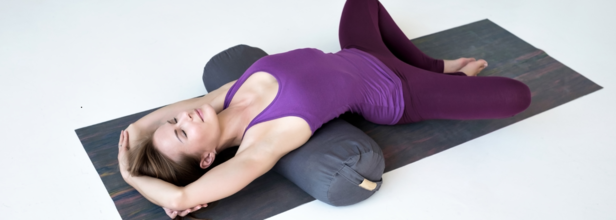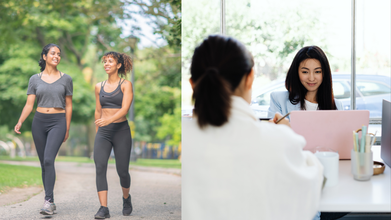- Health Conditions A-Z
- Health & Wellness
- Nutrition
- Fitness
- Health News
- Ayurveda
- Videos
- Medicine A-Z
- Parenting
Get 8 Hours of Sleep In 10 Minutes With This Yoga Asana

Yoga's added benefits, apart from the usual, well-known offerings, also include getting a good night's sleep, something that many tend to overlook. One such vibrant pose is Supta Sukhasana, often referred to as the 'Reclined Happy Pose.'
In just under 10 minutes, this gentle asana can help you calm down, relax and ready your body for a good night's rest.
What is Supta Sukhasana?
Supta Sukhasana is a restorative yoga pose in which you lie on your back, legs crossed at the ankles, and arms resting beside your torso. The pose promotes ease and profound relaxation. It's an excellent approach to ensure a calm transition to sleep. This pose is a happy pose as the term in Sanskrit literally translates into "happy pose". The term "sukh" means "happy" and "asana" means "pose".
Also Read: The Invisible Weight of Suicide Loss: Stories of Guilt, Love, and Healing
The Darshana Upanishad, a 4th-century Sanskrit Upanishad, describes the easy pose as a meditative sitting posture. The 19th-century Sritattvanidhi text from Karnataka also illustrates and describes the Sukhasana practice.
How to Practice Supta Sukhasana?
- Find Your Space: Choose a quiet, comfortable spot where you won't be bothered. A softer surface, such as a yoga mat, is preferred.
- Assume the Position: Sit on the mat, cross your legs comfortably, and gradually lie back. Make sure your lower back is supported, whether by the ground or a folded blanket.
- Get Comfortable: Spread your arms across your body, palms facing up. This pose widens the chest and promotes relaxation.
- Concentrate on your breathing: Take deep, peaceful breaths, closing your eyes. Inhale deeply through your nose, allowing your abdomen to rise, then gently exhale through your mouth. Let your breath be the focal point of your practice.
- Release Tension: As you breathe, actively relax your body. Consider how each breath eases stress and discomfort.
- Stay for 10 Minutes: Hold this position for approximately ten minutes. If your thoughts begin to wander, softly return your attention to your breath.
Supta Sukhasana Benefits
1. Calms Your Nervous System Fast
This pose switches your body from stress mode to rest mode. Your heart rate slows, breathing deepens, and that anxious, wired feeling starts to fade within minutes.
2. Releases Hip and Lower Back Tension
All that sitting and stress gets stored in your hips. The gentle leg crossing unlocks tightness you didn't even know was there, often releasing emotional tension too.
3. Improves Sleep Quality Naturally
Practice this before bed for two weeks and you'll notice you fall asleep faster and stay asleep longer. It's not magic—just your body learning to wind down properly.
4. Reduces Daily Stress and Anxiety
Regular practice makes you less reactive during the day. That overwhelming feeling when everything piles up? This pose gives you a reset button you can actually use.
5. Opens Chest and Improves Breathing
The arms-out position reverses that hunched-over-a-desk posture. Your chest opens, you breathe deeper, and suddenly there's more space in your body and mind.
Incorporating Supta Sukhasana into your nighttime routine is a simple yet efficient technique to indicate to your body that it's time to relax. Try this asana tonight and feel the relaxing effects for yourself! Use pillows under your back for extra support if needed.
10,000 Steps Cannot Undo The Damage Caused By A 9-Hour Desk Job, According To Doctor

Credits: Canva
For many people, completing a daily step goal feels like a sign of an active lifestyle. Fitness trackers, wellness challenges and social media trends have popularized the belief that 10,000 steps can undo the negative effects of long hours spent at a desk. However, vascular experts warn that this assumption is misleading. Prolonged sitting continues to damage the veins and circulation even if one walks later in the day.
Vascular Surgeon and Varicose Vein Specialist Dr Sumit Kapadia recently posted a video on his Instagram channel explaining why step counts alone cannot protect vascular health. He said this is something he tells his patients almost every day. Even if someone completes their step goal in the evening, the body has already endured hours of immobility that strain the veins.
According to Dr Kapadia, circulation does not depend on how much a person walks in total. Instead, it depends on how frequently they move. Long stretches of sitting from nine in the morning to seven in the evening cause blood to stagnate in the legs. This stagnation triggers a progressive cycle: vein valve weakness, swelling, varicose veins and, over time, an increased risk of developing blood clots.
Why Sitting for Long Hours Harms the Veins
When a person sits for too long, blood flow in the legs slows down. Veins must work harder to pump blood upward toward the heart, especially against gravity. The longer blood pools in the lower legs, the more pressure builds inside the veins. Over time, this weakens the valves that keep blood moving in the right direction.
Dr Kapadia explained that even a healthy step count cannot reverse ten hours of immobility. The veins experience stress and pressure throughout the day, and walking later does not undo the hours of stagnation already endured.
People with sedentary jobs, long commutes or limited movement throughout the day are especially at risk. Additional factors like being overweight, having a family history of venous disease, or standing for long hours without moving can worsen the impact.
Movement Frequency Matters More Than Step Count
According to Dr Kapadia, vascular health depends more on how often you move than how much you walk. The solution is not long-distance jogging or intense workouts after work, but small, consistent breaks during the day.
He offered a simple rule for preventing vein damage:
- Get up every 45 to 60 minutes.
- Stretch briefly to activate muscles.
- Walk for at least two minutes.
- Move your calf muscles, which act as the body’s “peripheral heart.”
Calf muscles play a major role in circulating blood back to the heart. When they contract, they push blood upward from the legs. But when they remain still for long periods, this pumping mechanism weakens. Small actions like ankle rotations, standing on tiptoes or short hallway walks can activate this pump and support vein health.
Small Breaks Make a Big Difference
Dr Kapadia emphasized that the veins do not need marathons. They need movement. Tiny breaks spread across the day help prevent swelling, heaviness, varicose veins and long-term complications such as deep vein thrombosis.
In a world where work, travel and digital life keep people sitting for most of the day, this message is more relevant than ever. Steps matter, but frequency matters far more. The key to healthy veins is simple: move often.
What Is Calisthenics? The Bodyweight Exercise Trending In The Fitness World

Credits: Canva
Strength training, also known as resistance training, involves working your muscles against some form of resistance, which helps them grow stronger and larger. It is an essential part of any fitness routine. While lifting weights is the most common form of strength training, there are several other ways to practice it.
One such method is calisthenics, which relies on your own body weight as resistance. Though both weightlifting and calisthenics fall under strength training, they produce different outcomes. Choosing the right one depends on your personal fitness objectives. Lately, calisthenics has been gaining renewed attention in the fitness world. Below, we break down what calisthenics is and whether it might be better for your workouts.
What Is Calisthenics?
Calisthenics is a workout style that primarily uses your body weight and often requires minimal or no equipment. Common calisthenics exercises include pushups, squats, crunches, planks, burpees, pullups, and lunges. These movements typically involve large muscle groups, like those used in pushups. Most people perform them at a moderate pace to improve coordination, flexibility, and overall strength. The practice of calisthenics dates back to Ancient Greece and continues to be popular today. It is accessible to people of all fitness levels, and many exercises don’t need any equipment at all.
How Effective Is Calisthenics?
Research indicates that calisthenics can improve everything from muscular strength to cardiovascular fitness, according to Anatolia Vick-Kregel, director of the Lifetime Physical Activity Program at Rice University. “Body weight is phenomenal,” she noted.
However, there are some limitations, said John Raglin, professor of kinesiology at the Indiana University School of Public Health, Bloomington. “It can be effective,” Raglin explained. “But thinking it can fully replace even simple equipment isn’t entirely correct.” Using equipment can sometimes make exercises easier or safer. Many people, for example, perform pushups with incorrect form. “If someone lacks strength or has joint problems or arthritis, lying on a bench and using light hand weights can be both safer and more practical,” he added.
Is Calisthenics Better Than Weightlifting?
Calisthenics tends to burn more calories, which can help reduce body fat and support weight loss. That’s because these exercises involve continuous movement, requiring more energy, which the body gets by burning calories. The higher the energy expenditure, the greater the potential for weight loss. Healthline notes that calisthenics can also be included in high-intensity workouts like HIIT or circuit training, further boosting calorie burn.
Weightlifting, on the other hand, focuses on isolated movements that don’t demand as much energy. Still, it contributes to weight management by increasing muscle mass, which raises your basal metabolic rate—the calories your body burns at rest.
Can You Combine Calisthenics And Weightlifting?
Combining the two methods is an excellent way to enjoy the benefits of both.
There are a few approaches to merging calisthenics with weightlifting:
- Same-day approach: Include both calisthenics and weightlifting exercises in one strength-training session.
- Alternate-day approach: Focus on one method per day, alternating between calisthenics and weightlifting throughout the week.
Since both forms provide resistance to your muscles, it’s important not to overdo it. Include rest days and listen to your body. For the best guidance on blending calisthenics and weightlifting, consult a personal trainer. They can tailor a program with the right exercises to suit your specific goals.
Delhiites, Skip Your Morning Walk, You May Be Inhaling 3x Toxic Air Than Usual, According To Doctor

Credits: PTI
As of November 19, 7am, Delhi's AQI as per the official data stands at 388, however, as per aqi.in, the average AQI of the city stands at 601 at 8.50 am. While there has been data discrepancies, as a result of which, people have come to street to protest against the continuous worsening air quality of the national capital. Amid this, Dr Manan Vora, a Mumbai-based orthopedic surgeon and sports doctor shared some tips to stay safe amid polluted air.
While watching a video of a person cleaning their clogged air purifier, Dr Vora says, "Your air purifiers can change filters but your lungs cannot," and suggests the following 5 tips:
Creation Of Clean Room
The first tip Dr Vora shares is to create a clean room, which can reduce exposure of pollutants by 60 to 70%. This could be achieved by an air purifier. He suggests everyone to decide one room in the house and shut its doors, and windows during peak hours, and turn on air purifier only in that room. "This alone curbs your exposure by 60 to 70%," he says.
Wear N-95 Mask
The doctor advises to wear an N-95 mask whenever someone is stepping outdoors. He mentions that a cloth or a surgical mask won't protect them against the pollutants, as N-95 masks are the only protective gears with filters that can keep the pollutants out when you breathe. "Only N-95 blocks the same particles clogging the purifier," he says, referring to a video of cleaning a clogged air purifier's filter.
Skip Morning Walks
"Skip your morning walks," he suggests. "AQI is highest at the sunrise and breathing rate triples while exercising. This means you inhale three times more pollution per minute," he says.
This happens because pollutants accumulate overnight, and without wind or sunlight, PM2.5 or the particulate matter stays trapped near the ground, leading to pollution being at its peak by sunrise. As per the data by aqi.in, highest AQI is always registered between 6am to 9am.
Use Wet Mop
Dr Vora suggests that while cleaning your house, instead of dry dusting, use a wet mop, this reduces dust particles. "Dry dusting pushes all the particles back into the air," he says.
Hydrate Your Self, Check On Your Check
The fifth tip he shares is to stay hydrated and consume vitamin C and other antioxidant-rich foods. As per the National Institutes of Health (NIH), US, vitamin C increases resistance to various viral and bacterial infections. A 2007 study published in the Journal of the Royal Society of Medicine noted that vitamin C or its supplement could in fact help patients with pneumonia or other lung-related disease. Thus vitamin C is a good boost for when lungs are at high risk, all thanks to the pollution.
The doctor also suggests the consumption of amla or Indian gooseberry and turmeric to boost your immunity. However, the doctor notes that while they do not cure pollution, but consuming these may reduce inflammation caused by pollutants.
"You cannot fix the AQI of your city, but you can control how much of it enters your body."
© 2024 Bennett, Coleman & Company Limited

